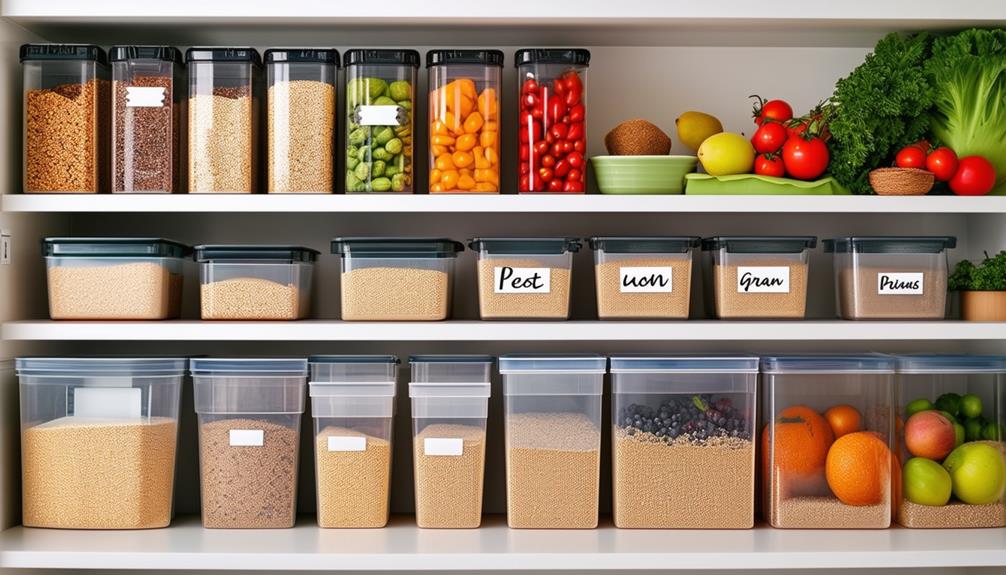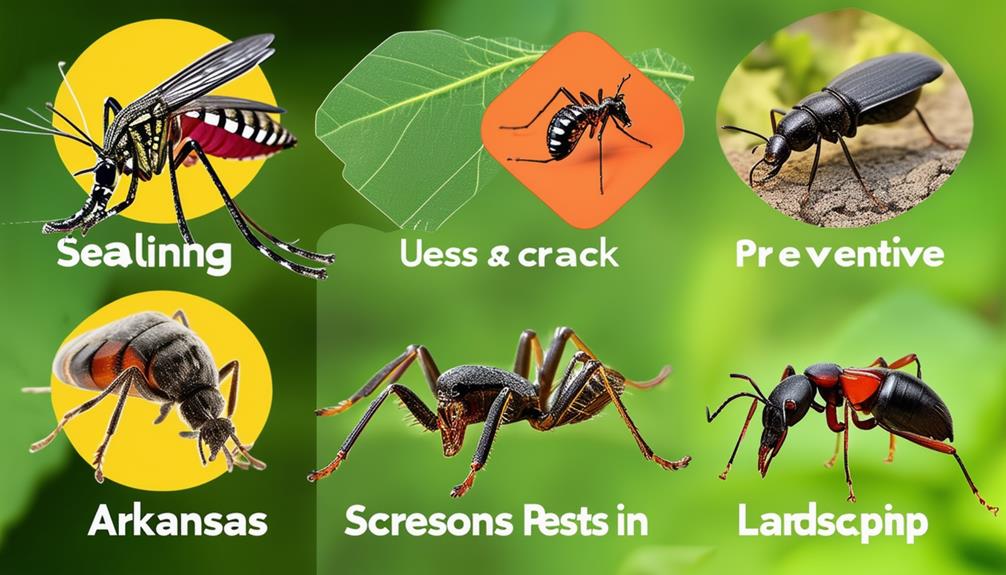When it comes to safeguarding your stored food against pests in Arkansas, a proactive approach is key. Imagine a scenario where your pantry remains pest-free, and your ingredients stay uncontaminated. By following a few simple yet essential practices, you can guarantee the integrity of your food supply. But what are these practices, and how can they be seamlessly integrated into your routine? Let’s explore the ins and outs of effective food storage strategies that will not only protect your provisions but also provide peace of mind.
Key Takeaways
- Keep food in airtight containers to prevent pest infiltration and spoilage.
- Maintain moisture levels below 10% to deter pests like weevils and beetles.
- Store food in cool, dry, dark areas to discourage pest activity.
- Regularly inspect containers for signs of pest presence to take early action.
- Utilize traps and lures for early detection of pests in food storage areas.
Importance of Proper Food Storage
Proper food storage is essential for preventing insect infestation and food spoilage in Arkansas. When it comes to pest management, storing food correctly is vital. Make sure to use airtight containers to keep pests out and maintain food quality. Oxygen absorbers can help in preserving freshness during storage, especially in a humid environment like Arkansas. Ensuring that the moisture content remains below 10% is key to effective food storage and preventing mold growth.
Incorrect food storage not only leads to food spoilage but can also pose health risks due to bacterial contamination. By following proper techniques, you can avoid inedible and hazardous food situations. Whether storing grains, dried fruits, or other pantry staples, taking the time to seal items correctly can make a significant difference in preserving their quality. In Arkansas, where the climate can be conducive to pest infestations, the importance of proper food storage can’t be overstated.
Choosing the Right Containers
Selecting the appropriate containers is vital for safeguarding your stored food from pests and maintaining its freshness. When choosing the right containers for storing food to avoid pests in Arkansas, consider the following guidelines:
- Airtight Containers: Opt for containers that are airtight to prevent pests from infiltrating your stored food.
- Secure Lids: Containers with secure lids help maintain freshness by keeping out insects and other contaminants.
- Transparent Containers: Choose transparent containers to easily monitor food quality and spot any potential pest presence.
- Food-Grade Material: Use food-grade plastic or glass containers to ensure safe and effective storage.
It’s important to select containers with features like silicone seals for an extra layer of protection against pests and contaminants. By following these recommendations, you can effectively keep pests at bay and preserve the quality of your stored food in Arkansas.
Controlling Moisture Levels
To effectively safeguard your stored food from mold growth and insect infestation, maintaining moisture levels below 10% is crucial. High humidity can create a conducive environment for pests like weevils and beetles to thrive in food storage areas.
To combat this, consider using dehumidifiers to lower moisture levels and prevent dampness. Regularly monitor humidity levels to guarantee they stay within the recommended range to deter mold growth and pest infestation.
Implementing moisture control measures, such as proper ventilation and sealing containers tightly, can help in preventing excess dampness. By taking proactive steps to control moisture, you can mitigate the risk of food spoilage, degradation, and the growth of harmful bacteria and fungi, ultimately safeguarding the quality and safety of your stored food.
Ideal Storage Conditions
For best preservation of your food items in Arkansas, make sure they’re stored in cool, dry, and dark locations to deter pests. Maintaining important storage conditions is vital for ensuring the longevity of your food supply. Here are some key factors to keep in mind:
- Temperature Control: Keeping your stored food at a consistent temperature helps prevent pests from thriving.
- Humidity Levels: Maintaining a moisture content below 10% is essential in deterring pests attracted to damp environments.
- Airtight Containers: Utilizing airtight containers with oxygen absorbers can greatly reduce the risk of pest infestation in long-term food storage.
- Proper Sealing: Ensuring containers are properly sealed not only helps in pest prevention but also prevents oxidation which can compromise the quality of your stored food.
Regular Inspection Practices
Regularly inspect stored food containers for any signs of pest activity to proactively prevent infestations and maintain food quality. Pest prevention is key, so be vigilant for holes, webbing, or any insect sightings that may indicate an issue.
Additionally, keep the surrounding area clean of spills or crumbs that could attract pests to the storage location. Utilize inspection techniques like traps or pheromone lures to aid in early detection of pests in stored food areas.
Establish a schedule for routine inspections to catch any potential pest problems early on. By maintaining a consistent inspection routine, you increase the likelihood of early detection, which is essential for effective pest management.
Remember to keep detailed records of your inspection findings and actions taken to address any pest issues in the storage area. Early detection through regular inspections is a fundamental aspect of effective pest control and food storage maintenance.
Educating on Storage Techniques
When storing food to avoid pests, it’s essential to educate yourself on proper container selection, temperature control methods, and regular cleaning practices.
Airtight containers and oxygen absorbers help maintain food freshness and prevent pest intrusion.
Utilizing temperature control methods like the freeze-thaw-freeze technique can eliminate insect eggs and larvae effectively.
Proper Container Selection
In order to guarantee the protection of your stored food from pests, prioritize selecting airtight containers with secure lids. When choosing containers, consider the following:
- Container durability: Opt for sturdy materials like food-grade plastic or glass to ensure longevity and prevent pests from accessing the food.
- Seal effectiveness: Look for containers with silicone seals that provide an extra layer of protection against pests and moisture infiltration.
- Size considerations: Select a container size that matches the quantity of food being stored to minimize air exposure and maintain freshness.
- Transparency advantage: Transparent containers allow for easy identification of stored items and help in monitoring food freshness levels effectively.
Temperature Control Methods
To guarantee the longevity of your stored food and protect it from pests, mastering temperature control methods is vital. Maintaining a consistent temperature below 60°F is pivotal to prevent insect activity and preserve food quality by avoiding condensation and mold growth.
Utilizing temperature-controlled storage areas or cool, dry spaces can extend the shelf life of your stored food. It’s important to be wary of extreme heat, as it can accelerate insect reproduction, underscoring the significance of temperature regulation.
Employing temperature monitoring devices like thermometers or data loggers can assist in ensuring ideal storage conditions. Additionally, implementing climate control measures and thermal insulation can help create stable environments for your stored food, safeguarding it against pest infestations.
Regular Cleaning Practices
For essential food storage and pest prevention, educating yourself on regular cleaning practices is vital to maintain a hygienic storage environment. Here are some key points to ponder:
- Sweeping techniques, pest prevention: Regularly sweep and clean bin floors to eliminate old grain and prevent pest infestation.
- Grain residue, storage maintenance: Make sure spilled grain near the bin is promptly cleaned to avoid attracting pests. Also, ensure augers are free of old grain residue to uphold a pest-free storage environment.
- Sanitation practices, insect deterrence: Treat bin floors and walls with residual insecticide before storing fresh grain to deter pests. Proper sanitation practices play a critical role in preventing insect attacks and maintaining food quality during storage.
Sharing Experiences for Improvement
By engaging in discussions with fellow food storage enthusiasts, you can gain valuable insights and tips for enhancing your pest prevention strategies. Sharing experiences with others who’ve dealt with similar challenges can provide you with new perspectives on effective storage solutions. Learning from their mistakes and successes can help refine your own techniques, making your pest prevention methods more robust.
Networking with like-minded individuals not only fosters a sense of community sharing but also opens doors to new ideas and innovations in pest prevention practices. Collaborating with others in the community creates a supportive environment where maintaining proper food storage standards becomes a collective effort.
Engaging in discussions about food storage not only enriches your knowledge but also leads to a deeper understanding of best practices, facilitating continuous improvement in your pest prevention strategies. Remember, the more you interact with others in the food storage community, the more you can refine and enhance your pest prevention methods.
Frequently Asked Questions
How Do You Store Food to Prevent Pests?
To prevent pests, store food properly by using airtight containers with oxygen absorbers in cool, dry areas. Regularly inspect for spoilage or pests. Avoid improper lids. Use freeze-thaw-freeze method to eliminate eggs. Keep food fresh and pest-free.
What Is the Best Way to Prevent Pest Infestation for Food Handlers?
To prevent pest infestation, you should implement pest control strategies, food safety measures, and hygiene practices. Regularly inspect food containers, use airtight storage, and store in cool areas. Remember, prevention is key!
How Can We Protect Food Resources From Pests?
To safeguard food resources from pests, maintain proper food storage and preservation techniques. Regular cleaning and insecticide treatment of bins prevent infestations. Follow USDA and Arkansas guidelines for effective pest prevention. Safety first in food storage in Arkansas.
Which Method Is Best for Controlling Stored Grain Insect Pests?
When it comes to controlling stored grain insect pests, the best method is Integrated Pest Management. Utilize aeration systems, pheromone traps, and proper sanitation. Actellic, Malathion, and Centynal insecticides are effective, and fumigation with caution can combat infestations.




